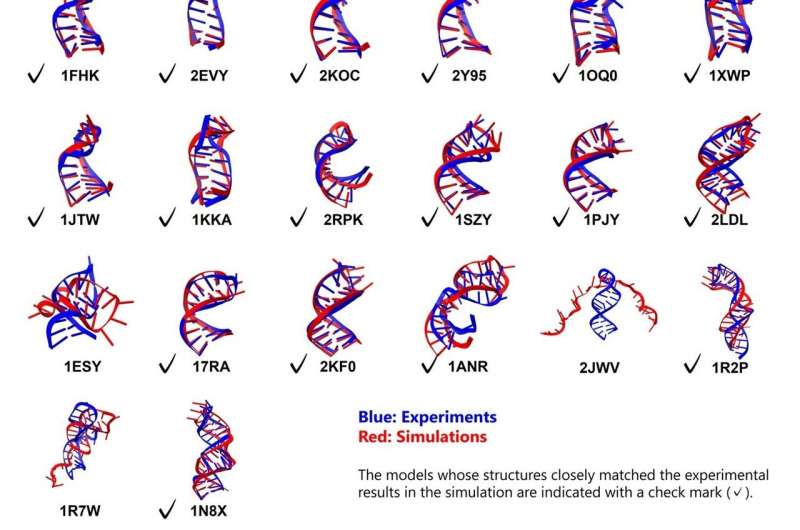Science
New Simulations Revolutionize Understanding of RNA Folding

Researchers at the Tokyo University of Science, led by Associate Professor Tadashi Ando, have achieved a significant breakthrough in understanding RNA folding through advanced molecular dynamics simulations. Published on November 4, 2025, in the journal ACS Omega, this study represents a pivotal step in modeling the complex structures of RNA, which play essential roles in various biological processes.
RNA, or ribonucleic acid, is crucial not just as a carrier of genetic information but also for gene regulation and processing. Its ability to adopt intricate three-dimensional shapes is vital for its various functions. With the increasing prominence of RNA-based therapeutics, accurately predicting RNA structures has become essential for advancing biotechnology and developing new medical treatments.
Breakthroughs in Molecular Dynamics Simulations
Despite the critical importance of RNA folding, simulating the complete folding process from an unfolded state has long posed challenges in computational biophysics. Traditional molecular dynamics (MD) simulations have struggled to model complex folding accurately, often only successfully simulating simple structures.
In his recent research, Dr. Ando conducted an extensive evaluation of modern simulation techniques. He sought to determine whether a combination of advanced computational tools could effectively model a significantly larger and more diverse set of RNA stem loops than previously attempted. This study involved using the DESRES-RNA atomistic force field, refined for RNA simulations, along with the GB-neck2 implicit solvent model, which simplifies the modeling of surrounding liquids.
This innovative approach allowed for accelerated conformational sampling, improving the efficiency of the simulations compared to traditional explicit solvent models.
Results and Implications for RNA Research
Dr. Ando applied this methodology to a selection of 26 RNA stem-loops, with lengths ranging from 10 to 36 nucleotides, encompassing various structural complexities, including bulges and internal loops. Remarkably, 23 out of the 26 RNA molecules successfully folded into their expected structures. For the 18 simpler stem loops, the simulations achieved impressive accuracy, with root mean square deviation (RMSD) values of less than 2 Å for the stem regions and under 5 Å for the overall structures.
Among the more challenging motifs, five out of eight with bulges or internal loops were accurately folded. This study marks a significant milestone, as Dr. Ando noted, “Previous studies have reported only two or three folding examples of simple stem-loop structures of approximately 10 residues, whereas this study deals with structures of much greater scale and complexity.”
The successful simulation of folding across such an extensive and complex library highlights the reliability of the combined DESRES-RNA and GB-neck2 tools for investigating large-scale conformational changes in RNA. Furthermore, the study identified areas for further refinement of these computational tools.
While the stem regions exhibited high accuracy, the loop regions showed less precision, with RMSD values around 4 Å. This suggests that optimization is needed for the implicit solvent model, particularly in modeling non-canonical base pairs and the effects of divalent cations like magnesium.
The implications of this research extend to the development of RNA-based medical tools. Understanding RNA folding is crucial for designing drugs that can effectively target RNA, potentially leading to new treatments for genetic disorders, viral infections such as COVID-19 and influenza, and certain cancers. “The ability to reproduce the overall folding of the basic stem-loop structure is an important milestone in understanding and predicting the structure, dynamics, and function of RNA,” Dr. Ando concluded. “I expect this computational technique to lead to applications in RNA molecule design and drug discovery.”
This research not only advances the field of computational biology but also opens new avenues for therapeutic development, emphasizing the critical role of RNA in health and disease management.
-

 Science3 weeks ago
Science3 weeks agoIROS 2025 to Showcase Cutting-Edge Robotics Innovations in China
-

 World3 weeks ago
World3 weeks agoBravo Company Veterans Honored with Bronze Medals After 56 Years
-

 Politics3 weeks ago
Politics3 weeks agoJudge Considers Dismissal of Chelsea Housing Case Citing AI Flaws
-

 Lifestyle3 weeks ago
Lifestyle3 weeks agoStone Island’s Logo Worn by Extremists Sparks Brand Dilemma
-

 Health3 weeks ago
Health3 weeks agoStartup Liberate Bio Secures $31 Million for Next-Gen Therapies
-

 Top Stories3 weeks ago
Top Stories3 weeks agoIndonesia Suspends 27,000 Bank Accounts in Online Gambling Crackdown
-

 Health3 weeks ago
Health3 weeks agoTop Hyaluronic Acid Serums for Radiant Skin in 2025
-

 Sports3 weeks ago
Sports3 weeks agoMel Kiper Jr. Reveals Top 25 Prospects for 2026 NFL Draft
-

 World3 weeks ago
World3 weeks agoHoneywell Predicts Record Demand for Business Jets Over Next Decade
-

 Lifestyle3 weeks ago
Lifestyle3 weeks agoMary Morgan Jackson Crowned Little Miss National Peanut Festival 2025
-

 Sports3 weeks ago
Sports3 weeks agoYamamoto’s Mastery Leads Dodgers to 5-1 Victory in NLCS Game 2
-

 Science3 weeks ago
Science3 weeks agoArizona State University Transforms Programming Education Approach









